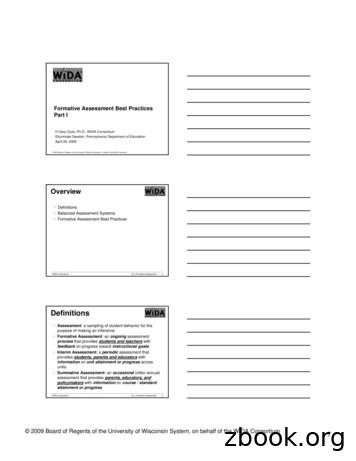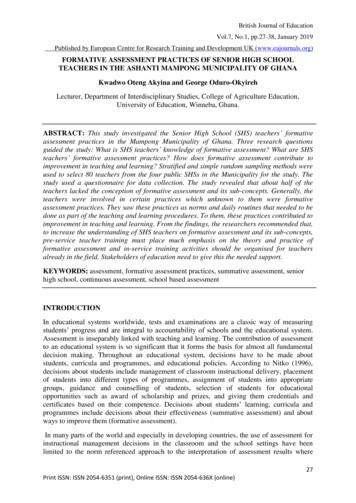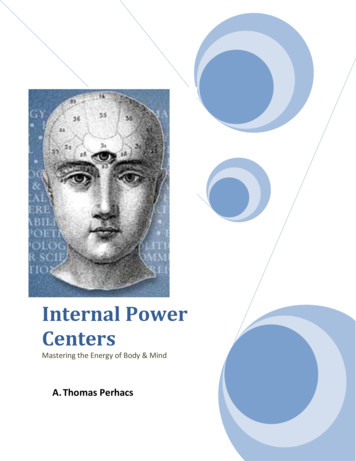DISTINGUISHING FORMATIVE ASSESSMENT FROM OTHER EDUCATIONAL .
DISTINGUISHINGFORMATIVE ASSESSMENTFROM OTHER EDUCATIONALASSESSMENT LABELSFormative Assessmentfor students and teachersPREPARED BY THE FORMATIVE ASSESSMENTFOR STUDENTS AND TEACHERS (FAST) SCASSMEMBERS ARKANSAS, CONNECTICUT, HAWAII, ILLINOIS, IOWA,KANSAS, KENTUCKY, MARYLAND, MICHIGAN, NORTH CAROLINA,AND WEST VIRGINIA.
The FAST SCASS gratefully acknowledges the invaluable assistance of Jim Popham, Dylan Wiliam,and Margaret Heritage in the preparation of this paper.STATE REPRESENTATIVESSuzanne Knowles - ArkansasSherri Thorne – ArkansasPatricia Foley – ConnecticutJoseph Di Garbo – ConnecticutMonica Mann – HawaiiRampal Singh – HawaiiGil Downey – IllinoisRachel Jachino – IllinoisColleen Anderson - IowaMichelle Hosp – IowaJackie Lakin, KansasJeannette Nobo – KansasJoy Barr - KentuckySean Elkins – KentuckyDenise Hunt – MarylandGreg Sucre – MarylandEd Roeber - MichiganKimberly Young – MichiganCarmella Fair – North CarolinaSarah McManus – North CarolinaStacey Murrell – West VirginiaDenise White – West VirginiaSonya White – West VirginiaAFFILIATE MEMBERSMichael Kaspar - National Education AssociationStuart Kahl – Measured ProgressKelly Goodrich – NWEASally Venezuela – CTB/McGraw-HillThe FAST SCASS also thanks Debra Hawkins, Issaquah School District, WA and JohnHosp,University of Iowa for their support in the preparation of this paper.Any opinions expressed in this paper are those of the FAST SCASS and not necessarily of CCSSO.
THE COUNCIL OF CHIEF STATE SCHOOL OFFICERSThe Council of Chief State School Officers (CCSSO) is a nonpartisan, nationwide, nonprofit organization ofpublic officials who head departments of elementary and secondary education in the states, the District ofColumbia, the Department of Defense Education Activity, and five U.S. extra-state jurisdictions. CCSSO pro vides leadership, advocacy, and technical assistance on major educational issues. The Council seeks memberconsensus on major educational issues and expresses their views to civic and professional organizations,federal agencies, Congress, and the public.DISTINGUISHING FORMATIVE ASSESSMENT FROMOTHER EDUCATIONAL ASSESSMENT LABELSCOUNCIL OF CHIEF STATE SCHOOL OFFICERSThomas Luna (Idaho), PresidentGene Wilhoit, Executive DirectorCouncil of Chief State School OfficersOne Massachusetts Avenue, NW, Suite 700Washington, DC 20001-1431Phone (202) 336-7000Fax (202) 408-8072www.ccsso.orgCopyright 2012 by the Council of Chief State School Officers, Washington
INTRODUCTIONIn 2006, based on a close review of the literature on formative assessment and in consultation with nationaland international experts on the topic, the Council of Chief State School Officers’ (CCSSO) FormativeAssessment for Students and Teachers (FAST) State Collaborative on Assessment and Student Standards(SCASS) developed a now widely cited definition of formative assessment:“Formative assessment is a process used by teachers and students during instruction thatprovides feedback to adjust ongoing teaching and learning to improve students’ achievementsof intended instructional outcomes.”Central to our view is that formative assessment takes place during the course of ongoing instructionto support student learning as it develops. This stands in contrast to summative assessment, or interimassessment, that is intended to evaluate or benchmark what students have achieved after a particular phasein their schooling — for example, after a course or a unit of study (NRC, 2001). We also stress studentinvolvement in formative assessment through peer- and self-assessment, and the use of feedback bystudents to move their learning forward.While there is general agreement among the FAST SCASS member states and other groups (e.g., theAssessment Reform Group in the U.K. and the International Network for Assessment for Learning)concerning the nature and purpose of formative assessment, the term itself is often used in differentways throughout the field of education. In this document, the FAST SCASS aims to clarify the meaningand uses of the types of assessment most frequently used in education. By so doing, the FAST SCASSintends to clarify what formative assessment is and is not in order to increase both the understanding andimplementation of formative assessment practices in classrooms.We have identified a modest collection of the labels that are currently used to describe various educationalassessment types. Assessment, in our view, includes more than traditional paper-and-pencil testing,although paper-and-pencil tests do, indeed, represent one useful way for educators to arrive at inferencesabout students’ current knowledge and skills. In a context of formative assessment, evidence gathering mayrange from dialogic conversations that enable teachers to elicit student thinking, to student peer- or selfassessment, to the completion of elaborate, extended-duration tasks.The FAST SCASS regards formative assessment practices as essential tools for teachers in supportingstudents to meet the rigorous Common Core State Standards, which emphasize higher levels of thinking forall students.BACKGROUND ON ASSESSMENTAny assessment is basically a process for making inferences about individuals or a group of individuals.Sometimes these inferences take the form of measurements — we want to be able to say that this studentknows more third grade mathematics than that student. However, measuring the amount of knowledge ofthird grade mathematics possessed by a student is not as straightforward as measuring the weight of anobject on a scale, measuring the length of a table with a ruler, or measuring air temperature by observingthe expansion of mercury against a calibrated scale. In an assessment context, measurement is indirect —we cannot directly observe what is going on inside a student’s head (and it probably wouldn’t tell us muchif we could!). We can only observe how a student responds to a series of questions, prompts, or tasks. Wehypothesize that correct responses to these questions, prompts, and tasks require the possession of certainDISTINGUISHING FORMATIVE ASSESSMENT FROM OTHER EDUCATIONAL ASSESSMENT LABELS4
knowledge, skills, or capabilities, so when one student does better than another, we infer that this is becausethey have more of the knowledge, skills, or capabilities we are most interested in.At other times, however, the inferences may take the form of classifications rather than measurements.We may infer that one student has sufficiently mastered third grade mathematics to proceed to the fourthgrade, while another has not. Although this inference could be based on a measurement, it could also bebased on a careful comparison of the many things the student can do, and the things the student needs tobe able to do to thrive in the fourth grade.In any assessment, as in all measurement, there is a degree of uncertainty related to the accuracy of themethod used for collecting evidence of learning and the way that evidence is used. One set of test itemsmay be much better at eliciting evidence of student mastery of a particular concept than a different, butsimilar looking set. The outcome of any assessment also depends on a variety of other factors, such as howthe student was feeling that day, the reliability of the rater, and so on.Thus, assessment is about trying to understand what or how much is “in a student’s head.” A centralcomponent of formative assessment is helping teachers learn how to elicit such evidence so their insightsinto student thinking can be used to advance learning. Since we cannot measure directly, we ask questionsthat attempt to get at knowledge or skills in order to make reasonable inferences.OUR DEFINITIONSIt is not our intent to provide a complete glossary of assessment terms. Rather, we offer a series offormative assessment terms and include a definition and brief commentary on each. The specific termsto be addressed in this paper are formative assessment, interim benchmark assessment, and summativeassessment. In addition, several other educational assessment terms are defined: diagnostic assessment,curriculum-embedded assessment, universal screening assessment, and progress-monitoring assessment.I. FORMATIVE ASSESSMENTThe FAST SCASS definition of formativeassessment developed in 2006 is“Formative assessment is a process usedby teachers and students during instructionthat provides feedback to adjust ongoingteaching and learning to improve students’achievements of intended instructionaloutcomes.”The attributes below have been identified ascritical features of effective formative assessment: Learning Progressions. Learningprogressions should clearly articulate thesub-goals of the ultimate learning goal Learning Goals and Criteria forSuccess. Learning goals and criteria forsuccess should be clearly identified andcommunicated to students Evidence of Learning. Evidence of learningis elicited during instruction Descriptive Feedback. Students should beprovided with evidence-based feedbackthat is linked to the intended instructionaloutcomes and criteria for success Self- and Peer-Assessment. Both selfand peer-assessment are important forproviding students an opportunity to thinkmeta-cognitively about their learning Collaboration. A classroom culture in whichteachers and students are partners inlearning should be established (McManus,2009)Commentary. FAST SCASS adopted this definitionof formative assessment as a process becausethe empirical evidence then available, and notcontradicted by subsequent research, stressed theDISTINGUISHING FORMATIVE ASSESSMENT FROM OTHER EDUCATIONAL ASSESSMENT LABELS5
importance of using ongoing assessment evidenceso that teachers could, if necessary, adjust theirinstructional activities, or students could adjusttheir learning tactics. Although not all of theattributes need to be present for the practice to beformative, in concert they enhance the process.II. INTERIM ASSESSMENTDefinition: Interim tests are typicallyadministered periodically throughoutthe school year (e.g., every few months)to fulfill one or more of the followingfunctions: predictive (identifying studentsreadiness for success on a later high-stakestest), evaluative (to appraise ongoingeducational programs), and/or instructional(to supply teachers with individual studentperformance data).Commentary. Also called “benchmark,”“interim benchmark,” “common,” or “quarterlyassessments,” these tests have become particularlypopular in recent years. Many interim tests wereoriginally marketed as though they were, in and ofthemselves, “formative assessments,” and yet, asHeritage recently reminded us in a CCSSO whitepaper.“The thesis of this paper is that, despite the pioneeringefforts of CCSSO and other organizations in the U.S.,we already risk losing the promise that formativeassessment holds for teaching and learning. The coreproblem lies in the false, but nonetheless widespread,assumption that formative assessment is a particularkind of measurement instrument, rather than a processthat is fundamental and indigenous to the practice ofteaching and learning” (2010).Often, interim assessments are used to predictstudents’ scores on subsequent high-stakes testssuch as a state’s annual accountability assessment.The rationale for such predictions is that the testcan identify students who are apt to be successfulor not likely to be successful on the subsequenttest. Assuming such students can be identified bythe use of interim tests, is seems sensible to supplytailored instruction for such students. However,after serious scrutiny of research studies on theeffectiveness of interim assessments in promotingstudents’ learning, it has been found that, at themoment, there is no meaningful evidence that suchassessments do, in fact, enhance student learning(Arter, 2010).Interim tests can provide periodic snapshots ofstudent learning. However, because they are notproximate to student learning as it is developing,they do not serve the purpose of informing ongoingteaching and learning.III. SUMMATIVE ASSESSMENTDefinition: Assessment referred toas summative is designed to provideinformation regarding the level of student,school, or program success at an end pointin time. Summative tests are administeredafter the conclusion of instruction. Theresults are used to fulfill summativefunctions, such as to (1) reach an evaluativejudgment about the effectiveness of arecently concluded educational program;(2) arrive at an inference about astudent’s mastery of the curricular aimssought during an in-class instructionalsequence; (3) arrive at a grade; or (4) meetlocal, state, and federal accountabilityrequirements.Commentary. Assessments referred to assummative can range from large-scale assessmentsystems, such as the annual assessmentsadministered across states, to district-wideassessment systems or tests, to classroomsummative tests created by teachers. In eachinstance, the assessments are designed to yieldinterpretations regarding students’ achievement orprogram success up to that point in time.Additional Definitions of Assessment Types.Listed below are several other assessment termsreferring to assessments processes/tests thatmay be viewed as synonymous with one or moreof the assessments described above. Our intent isto explain how these both differ and overlap withother types of assessment processes or uses ofassessment instruments.DISTINGUISHING FORMATIVE ASSESSMENT FROM OTHER EDUCATIONAL ASSESSMENT LABELS6
IV. DIAGNOSTIC ASSESSMENTDefinition: Diagnostic assessments areevidence-gathering procedures that providea sufficiently clear indication regardingwhich targeted subskills or bodies ofenabling knowledge a student possesses ordoes not possess — thereby supplying theinformation needed by teachers when theydecide how to most appropriately designor modify instructional activities. Becauseof the time intensive and specific nature ofdiagnostic assessments, they are only usedfor the subset of students identified as notmaking sufficient progress.Commentary. The function of the diagnosticassessment process is to provide informationto teachers about what is not being learnedif students are not making progress. Suchassessment information is most useful when itindicates to teachers or students what needs tobe done to progress learning. Because diagnosticassessments are only of genuine value whenthey provide a reasonably accurate estimate ofstudents’ status with respect to the curricular aimsbeing measured, it is important for these tests tocontain a sufficient number of items/tasks—perassessed curricular aim—to permit valid inferencesregarding students’ current status.When diagnostic tests provide teachers withimmediate, instructionally tractable information,they are a useful resource in the process offormative assessment.V. CURRICULUM-EMBEDDEDASSESSMENTDefinition: Curriculum-embedded testsare those that have been deliberatelyincorporated either in the instructionalmaterials being used by students or inthe instructional activities routinely takingplace.Commentary. In contrast to a distinct break in aninstructional sequence when students are told thatthey should put aside their materials in order “totake a test,” curriculum-embedded assessmentprovides an essentially non-intrusive way ofascertaining students’ current status with respectto the curricular aims being promoted by a teacher(or, more frequently, on the “en route” enablingsubskills and bodies of knowledge leading tostudent mastery of those curricular aims).The function of these assessments is more apt tobe formative when non-graded and used by bothteachers and students to support further learning.If they are used in the grading process, the onlyfeature that distinguishes this sort of assessmentfrom other summative assessment processesis the manner in which it has been blended intoongoing instructional activities.VI. UNIVERSAL SCREENINGASSESSMENTDefinition: Universal screening tests areperiodically conducted, usually two orthree times during a school year, to identifystudents who may be at risk, monitorstudent progress, or predict students’likelihood of success on meeting orexceeding curricular benchmarks. Universalscreening tests are typically brief andconducted with all students at a particulargrade level.Commentary. Universal screening measuresconsist of brief tests focused on target skills (e.g.,phonological awareness) that are highly predictiveof future outcomes (Ikeda, Neessen, & Witt,2008). Some universal screening assessmentsystems feature two or more forms of the sametests measuring student mastery of the samecurricular targets.Results of the screening assessment may beused to identify students needing more targetedprogress monitoring or more challenging curriculartargets. Within the formative assessment process,these assessment systems are used to identifystudents who subsequently need more frequent orintensive opportunities to reveal their knowledgeand skills during an instructional cycle.DISTINGUISHING FORMATIVE ASSESSMENT FROM OTHER EDUCATIONAL ASSESSMENT LABELS7
VII. PROGRESS MONITORINGASSESSMENTDefinition: Progress-monitoring tests areperiodically administered, typically weeklyor biweekly, to gauge students’ growthtoward mastery of (1) a target curricularaim or (2) the en route-subskills and bodiesof enabling knowledge contributing tostudents’ mastery of a target curricular aim.Commentary. If educators wish to ascertainthe degree to which their students are makingsatisfactory progress toward certain curriculartargets, then one way to do so is to administer,at different points during an instructionalsequence, tests specifically intended to gaugestudent progress. This could also be done, ofcourse, by re-administering precisely the sametest repeatedly. However, because students’interactions with earlier administrations of thesame test form or items may boost their scoreson subsequent test administrations (leading toless valid score-based inferences), most progressmonitoring assessments feature multiple formsof tests measuring students’ mastery of the samecurricular targets.SUMMARYWe have identified, defined, and commented on specific assessment types because we believe in theimportance of referring to tests and assessment processes accurately and consistently. Lack of clarityin labeling educational assessments and tests can lead to misunderstanding or even inadequate use ofassessments among educators. Formative assessment is particularly vulnerable as it is often misunderstoodor misinterpreted as a particular test or product, as opposed to a process used by teachers and theirstudents as an ongoing gauge of the current status of student learning. A clear understanding of formativeassessment is vital so that educators receive the assistance they need to learn how this valuable processcan be successfully deployed to improve their instruction and ultimately benefit student learning. Thisprofessional learning is essential to assuring that effective formative assessment practices are used in thenation’s classrooms to improve student achievement. DISTINGUISHING FORMATIVE ASSESSMENT FROM OTHER EDUCATIONAL ASSESSMENT LABELS8
REFERENCESArter, J. (2010, May). Interim benchmark assessments: Are we getting our eggs in the right basket? Paper presentedat National Council on Measurement in Education conference, Denver, CO.Heritage, M. (2010). Formative assessment and Next-generation assessment systems: Are we losing an opportunity?Washington, DC: CCSSO. Retrieved July 31, 2012, from ive Assessment and Next-Generation Assessment Systems.html.Ikeda, M.J., Neessen, E., & Witt, J.V. (2008). Best practices in universal screening. In A. Thomas & J. Grimes(Eds.), Best practices in school psychology (pp. 103-114). Bethesda, MD: National Association of SchoolPsychologists.McManus, S. (2009). The attributes of effective formative assessment. Washington, DC: CCSSO. RetrievedJuly 31, 2012, from http://www.ccsso.orgNati
assessment. In addition, several other educational assessment terms are defined: diagnostic assessment, curriculum-embedded assessment, universal screening assessment, and progress-monitoring assessment. I. FORMATIVE ASSESSMENT . The FAST SCASS definition of formative assessment developed in 2006 is “Formative assessment is a process used
--1-- Embedded Formative Assessment By Dylan Wiliam _ Study Guide This study guide is a companion to the book Embedded Formative Assessment by Dylan Wiliam. Embedded Formative Assessment outlines what formative assessment is, what it is not, and presents the five key strategies of formative assessment for teachers to incorporate into their
Performance Assessment Score Feedback Formative 1 Date . Formative 2 Date : Formative 3 Date . Formative 4 Date : Formative 5 Date . Formative 6 Date : Summative Date Implements learning activities aligned to chosen standards and incorporates embedded formative assessment. Clearly conveys objectives in student-friendly language so that the
Formative Assessment Best Practices Part I H Gary Cook, Ph.D., WIDA Consortium Elluminate Session, Pennsylvania Department of Education April 28, 2009 WIDA Consortium ELL Formative Assessment 2 Overview Definitions Balanced Assessment Systems Formative Assessment Best Practices ELL Formative Assessment 3 Definitions
assessment professional learning system. They are stepping stones along the path. Part I. Learn About Formative Assessment 1.1 Inventory your comprehensive assessment system. 1.2 Clear up misconceptions about formative assessment. Part II. Plan For Formative Assessment 2.1 Identify elements of formative practice that you do well and those you
FORMATIVE ASSESSMENT Formative assessment is any assessment that is used to improve teaching and learning. Assessment is a three-step process by which evidence is collected, interpreted and used. Best-practice formative assessment uses a rigorous approach in which each step of the
An assessment practice is only truly “formative” if the data is used to inform instructional practice and provide support to ensure student success. To learn more about formative assessment practices, visit the D PI Formative Assessment website, or utilize the Formative Assessment Professional Learning Modules .
formative assessment. Theoretical framework of the study Looking for a working description for formative assessment alongside summative assessment in the school setting, Madison-Harris, Muoneke and Times (2012) reviewed series of literature on formative assessment and concluded that "it is a systematic, continuous process
MaMa Internal Power Centers Mastering the Energy of Body & Mind A. Thomas Perhacs























